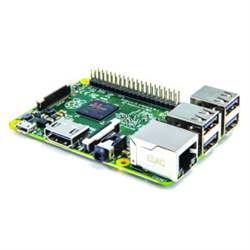Description
Complete kit to get you started with the Raspberry PiDevelop coding and computer skills using the incredibly popular Raspberry PiIdeal way to get children exposed to computer science and electronicsProduce your own projects with the Pi at the heart of themSupplied with the official NOOBs installer software on microSD which guides you through installing the operating systemThe Pi V2 feature a powerful 900MHz ARMv7 Quad Core CPU and 1GB of shared RAMGraphics handled by the VideoCore IV at 250MHzHDMI socket for HD video and composite PAL or NTSC signals from the combined 3.5mm AV socketIncludes 40 Pin GPIO pins to connect with electronic components and systems designed by youOn board Ethernet 10/100 port for network connections over cable and kit includes WIFI dongle for wireless connections4 USB ports onboard with additional ports from the external USB hubCSI Camera Port to connect to the Raspberry Pi Camera (Order Codes: A59NK and A68NK) DSI Display Port to connect directly to touch screen displaysKit includes keyboard, mouse, 4 port USB hub, WIFI dongle, HDMI cable, micro USB cable and 2 port USB power supplyWhat is it?Two years on from the release of the original Raspberry Pi, we are blessed with the Raspberry Pi 2, taking into account all of the developments and feedback from two years – the all new Raspberry Pi 2 boasts a much faster Broadcom ARM processor, larger RAM and the extended connectivity introduced in the B+ boards – and not only is it more powerful than the B+ but it requires less power – 3W compared to the 3.5W of the B+.To get you started we've put together a range of accessories which will help you start developing your own projects quickly, just add your own HDMI screen and enjoy. This kit is ideal to get started with the Pi and take full control of the powerful quad core processor and develop software or hardware and engage in the coding revolution taking place in schools, universities, workshops and at home.What can you do with a Pi?Raspberry Pi 2 is a fully functional computer and can be used as a computer with one of the desktop environments (see operating systems below for more details), it can also be used as a retro-gaming machine, home media centre, web and email server or can form the very advanced brain to a multitude of electronics projects – ideally suited for robotics and complex developments, but simple enough for children to quickly interface with languages such as Scratch.Operating system choice: Raspberry Pi 2 requires a micro SD card with an operating system (NOOBS 1.4 is recommended for beginners), but you are not limited to that, advanced users can choose from a range of generalised and specialised OS including; various Linux builds – Raspbian, Debian, OpenELEC, Fedora, Arc and other non-Linux platforms; RISC OS, FreeBSD, NetBSD, Plan 9, Inferno, OpenWrt. New to the Raspberry Pi 2 and thanks to the greater power and memory is support for Ubuntu and Windows 10.Proprietary connections on the board: 4 USB ports, dedicated connectors for cameras (CSI) and screens (DSI), common micro USB for power supply, microSD for storage, RJ45 network socket, HDMI for 1080p video out and a combination audio/video jack socket for connecting to audio equipment and older AV screens.Extended GPIO: One of the key selling points of the Raspberry Pi above standard computing platforms is the readily available GPIO pins that let you connect and interface to electronic projects, sensors and actuators. As with the previous board the extended GPIO set is present on the Raspberry Pi 2 board. (40 Pins – 28xGPIO, i2C, SPI, UART )To download the latest software for your Pi or play around with alternative Operating Systems then click hereFor instructions on how to install a Raspberry Pi Operating System please read this guideRaspberry Pi OS Final PDF >>
